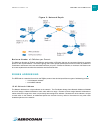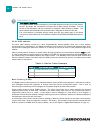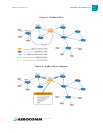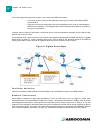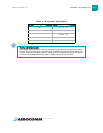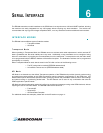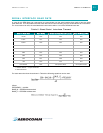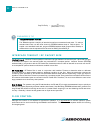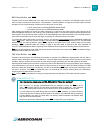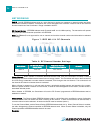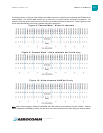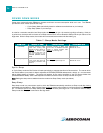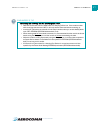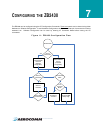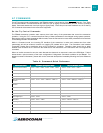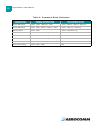
23
ZB2430 User’s Manual - v1.6
SERIAL INTERFACE
www.aerocomm.com
RXD Data Buffer and CTS
As data is sent from the OEM Host to the radio over the serial interface, it is stored in the ZB2430’s buffer until the
radio is ready to transmit the data packet. As discussed in “Interface Modes” on page 20, the radio waits to transmit
the data until one of the following conditions occur (whichever occurs first):
• The RF packet size is reached (EEPROM address 0x5B)
• An Interface Timeout occurs (EEPROM address 0x58)
After sending the packet over the RF the data continues to be stored in the buffer until the radio receives an RF
Acknowledgement (ACK) from the receiving radio (addressed mode), or all transmit retries/broadcast attempts have
been utilized. Once an ACK has been received or all retries/attempts have been exhausted, the current data packet is
removed from the buffer and the radio will begin processing the next data packet in the buffer.
To prevent the radio’s RXD buffer from being overrun, it is strongly recommended
that the OEM Host monitor the
radio’s CTS
output. When the number of bytes in the RXD buffer reaches the value specified by CTS_ON (EEPROM
address 0x5C), the radio de-asserts (High) CTS to signal to the OEM Host to stop sending data over the serial
interface. CTS is re-asserted after the number of bytes in the RXD buffer is reduced to the value specified by
CTS_OFF (EEPROM address 0x5D); signalling to the OEM Host that it may resume sending data to the transceiver.
Note: It is recommended that the OEM Host cease all data transmission to the radio while CTS
is de-asserted (High);
otherwise potential data loss may occur.
TXD Data Buffer and RTS
As data to be forwarded to the OEM Host accumulates, it is stored in the ZB2430’s outgoing buffer until the radio is
ready to begin sending the data to the OEM Host. Once the data packet has been sent to the Host over the serial
interface, it will be removed from the buffer and the radio will begin processing the next data packet in the buffer.
With RTS Mode disabled, the transceiver will send any data to the OEM Host as soon as it has data to send. However,
some OEM Hosts are not able to accept data from the transceiver all of the time. With RTS Mode Enabled, the OEM
Host can prevent the transceiver from sending it a data by de-asserting RTS
(High), causing the transceiver to store
the data in its buffer. Once RTS
is re-asserted (Low), the transceiver will continue sending data to the OEM Host,
beginning with any data stored in its buffer.
Note: Leaving RTS
de-asserted for too long can cause data loss once the radio’s TXD buffer reaches capacity.
ENGINEER’S TIP
Can I implement a design using just TXD, RXD and Gnd (Three-wire Interface)?
Yes. However, it is strongly recommended that your hardware monitor the CTS
pin of the
radio. CTS
is taken High by the radio when its interface buffer is getting full. Your hardware
should stop sending at this point to avoid a buffer overrun (and subsequent loss of data).
You can perform a successful design without monitoring CTS
. However, you need to take into
account the amount of latency the radio adds to the system, any additional latency caused by
Transmit Retries, how often you send data, non-delivery network timeouts and interface data
rate and the size of the packets.
Aerocomm can assist in determining whether CTS
is required for your application.



